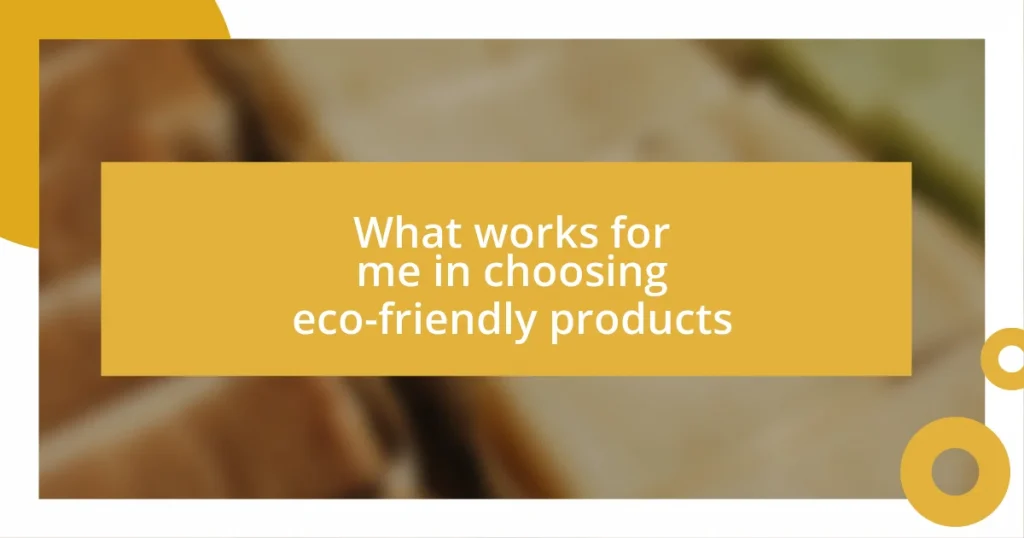Key takeaways:
- Embrace intentionality by keeping only items that add value; prioritize experiences over possessions for greater fulfillment.
- Decluttering leads to clarity and reduced stress, allowing for deeper connections and enhanced emotional resilience.
- Maintain minimalism through mindful choices, regular decluttering routines, and continual evaluation of one’s belongings and priorities.

Understanding minimalism principles
One major principle of minimalism is the idea of intentionality—only keeping things that truly add value to your life. I remember when I decided to declutter my closet; each piece I chose to keep had to spark joy or serve a purpose. It was liberating, but it also made me realize how often I held onto items out of guilt or obligation rather than genuine appreciation.
Embracing minimalism means prioritizing experiences over possessions. I recall a weekend spent hiking instead of shopping, which not only created lasting memories but also deepened my connection with nature. This shift in focus prompts me to ask: What if we prioritized time spent with loved ones or pursuing passions instead of accumulating more “stuff”?
Another essential principle is understanding that less is more. Initially, I struggled with this concept, often perceiving minimalism as a restriction. However, as I let go of excess, I discovered a sense of freedom I hadn’t known before. Each item I removed felt like shedding a layer of stress, leading me to an important question: Could simplifying my life truly lead to greater happiness?

Benefits of adopting minimalism
Adopting minimalism has transformed my life in ways I didn’t expect. One significant benefit I’ve found is the clarity it brings. When I reduced clutter in my living space, I noticed how much easier it was to focus on important tasks. It was as if a cloud lifted, allowing me to think more clearly and creatively. That feeling of mental ease is priceless.
Here are some key benefits that stood out to me on this journey:
- Reduced Stress: Simplifying my surroundings has created a calming atmosphere, reducing daily anxiety.
- Financial Freedom: With fewer possessions, I found myself spending less, allowing me to save for meaningful experiences.
- Increased Time: Less stuff means less time spent on cleaning and maintenance, which frees up my schedule for what truly matters.
- Enhanced Relationships: I’ve started prioritizing quality time with friends and family over material acquisitions, creating deeper connections.
- Emotional Resilience: Letting go of physical items has taught me the power of detachment, fostering a healthier emotional state.
Overall, embracing minimalism has not only lightened my physical load but enriched my emotional landscape in ways I’m continually grateful for.

Decluttering your living space
Decluttering your living space can be a transformative experience. I vividly remember the day I tackled my kitchen. Every drawer seemed a treasure chest filled with outdated gadgets and mismatched utensils. By letting go of items that no longer served a purpose, I created a space that felt organized and inviting. Cooking became a joy rather than a chore.
When I began decluttering, I set strict criteria for what to keep. An item had to be either useful or cherished. With that mindset, I filled several bags for donation in just a few hours. The sense of accomplishment that washed over me was incredible! Just as the space became brighter, I felt lighter mentally and emotionally. It’s fascinating how removing physical clutter can also lighten one’s emotional load.
Another powerful aspect of decluttering is discovering the beauty of simplicity. I used to think I needed a gadget for every task, but now I embrace multipurpose items. For example, I replaced my endless collection of serving dishes with a few simple, versatile ones. The space saved allowed me to create a peaceful corner for mindfulness practices, reminding me that wellness can flourish in simplicity.
| Before Decluttering | After Decluttering |
|---|---|
| Cluttered Spaces | Open and Airy Feel |
| Overwhelming Choices | Focus on Essentials |
| Stressful Environment | Calming Atmosphere |
| Time-Consuming Tidying | Quick Cleanups |

Simplifying your daily routines
Each morning, I used to feel overwhelmed just by deciding what to wear. After embracing minimalism, I simplified my wardrobe to just a few versatile pieces. This small change made my mornings smoother and more enjoyable. I found that having fewer choices actually boosted my creativity and helped me feel more confident. Have you ever considered how your daily decisions could be weighing you down?
When it comes to daily routines, I learned the importance of streamlining my tasks. I created a clear schedule prioritizing essential activities, which led to an unexpected bonus: I rediscovered pockets of free time. I realized that by eliminating the non-essential, I could now indulge in hobbies I had long neglected, like painting and reading. It’s fascinating how we often overlook the simple joys waiting for us once we clear the clutter from our lives.
I’ve also embraced batch cooking as a way to simplify meal prep. Instead of fretting every day about what to eat, I dedicate a couple of hours each week to preparing meals in bulk. This practice not only saves time but makes life much easier during busy weekdays. Imagine reaching into your fridge, only to find wholesome meals ready to go! It’s a game changer that allows me to maintain a healthy lifestyle while minimizing stress.

Mindfulness and minimalism connection
Mindfulness and minimalism go hand in hand, creating a harmonious space both physically and mentally. I found that as I decluttered my home, I also began decluttering my mind. It felt like a weight lifting off my shoulders—suddenly, I could focus on what truly mattered. Have you ever noticed how a clean environment can make your thoughts clearer?
Practicing mindfulness while embracing minimalism helped me stay present in the moment. I remember a serene afternoon where I sat in my newly simplified living room, sipping tea. Without distractions, I could feel the warmth of the cup in my hands, fully appreciating each sip. This awareness transformed a simple act into a soulful experience, reminding me just how enriching life can be when we remove the distractions.
What’s fascinating is how my approach to mindfulness changed fundamentally. Instead of rushing through activities, I learned to savor them. For instance, my minimalist kitchen motivated me to truly enjoy the process of cooking. I’d take my time chopping vegetables, appreciating their colors and textures. It’s interesting to think: when was the last time you fully engaged in something without the urge to rush? This deeper connection to my daily life has become one of the most profound gifts of minimalism.

Practical steps to start minimalism
Starting minimalism can feel daunting, but I’ve discovered a few practical steps that can ease the transition. One of the first things I did was tackle my belongings by using the “one in, one out” rule. For every new item I brought home, I made sure to donate or discard an old one. This practice not only reduced my clutter but also made me value each new purchase more deeply. Have you ever stopped to think about how much you truly need versus what you want?
Another significant step was setting a timer for decluttering sessions. I’d choose just 15-20 minutes to focus on one area, like my desk or a closet, rather than overwhelming myself with the entire house. It felt liberating to see real progress in such a short amount of time! During one session, I stumbled upon an old photo album I had forgotten about. Instead of throwing it away, I took a moment to enjoy those memories, reminding myself that not all clutter deserves to go.
Establishing a minimalist mindset goes beyond just physical items; it’s about choosing quality over quantity in all aspects of life. I began prioritizing experiences instead of things. For example, instead of spending money on another gadget, I opted for a weekend getaway with friends. That trip left me feeling richer in memories than any material possession could. Isn’t it intriguing how investing time in people can fill our lives with more joy than simply buying more stuff?

Maintaining a minimalist lifestyle
Maintaining a minimalist lifestyle requires more than just decluttering; it’s about mindfulness in each choice we make. I remember a time when I was tempted to buy a trendy new gadget. Instead of rushing into the purchase, I paused and reflected: would this truly add value to my life? That moment of contemplation helped me realize how often I had bought things on impulse. It’s a simple question, but it can lead to significant insights, don’t you think?
I’ve also found that creating routines around my minimalism helps in maintaining it. Have you ever tried designating specific times for decluttering? I began setting aside a regular Sunday afternoon to revisit my belongings—removing anything that no longer served a purpose. It felt almost like a ritual, where I’d light a candle and put on calming music, inviting peace into the process. This way, I didn’t just clean; I celebrated simplicity, reinforcing my commitment to a minimalist lifestyle.
Another key to sustaining minimalism is embracing the idea of continual evaluation. I often find myself reassessing my space and my priorities. For instance, I discovered that I had accumulated quite a few books I’d likely never read again. Realizing this felt liberating—I decided to donate them, allowing someone else to enjoy them while creating space in my home. Isn’t it fascinating how letting go can lead to a clearer mind? Each small act of detachment reaffirms my commitment to living simply and intentionally.













